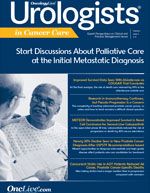Publication
Article
Oncology Live Urologists in Cancer Care®
Study Says Urologists in Solo Practice May Overuse Gonadotropin Agonists
Author(s):
Urologists who are in solo practice or not affiliated with a medical school may overuse primary gonadotropin-releasing hormone for men with localized prostate cancer.
Shellie D. Ellis, PhD, MA
Urologists who are in solo practice or not affiliated with a medical school may overuse primary gonadotropin-releasing hormone (GnRH) for men with localized prostate cancer, according to Shellie D. Ellis, PhD, MA, assistant professor of health policy and management at the University of Kansas School of Medicine. These urologists treat more vulnerable populations, which may contribute to health disparities in prostate cancer treatment quality.
Although primary GnRH agonists are recommended for men with metastatic disease and adjuvant to radiation for some men with localized disease, the use of these agents alone in localized disease is recommended only for a small group of patients, making most use in the absence of radiation overuse. Ellis and colleagues described physician-level patterns of overuse and the effect of time in practice and solo practice type on persistent GnRH agonist overuse.
In 2003, the Medicare Modernization Act (MMA) targeted wide variation in physician reimbursement of drugs covered under Medicare Part B (including GnRH agonists). The standardization, implemented incrementally in 2004 and 2005, decreased reimbursement for GnRH agonists by 65%.
With the cut in reimbursement, oncologists responded by increasing the use of recommended chemotherapies. Urologists, on the other hand, maintained GnRH agonist use in patients for whom it was recommended, but decreased overuse in patients for whom it was not recommended. By 2005, GnRH agonist overuse declined by 34%; however, 25.7% of men for whom it was not recommended still received this treatment in 2005.
In the current study, the final sample included 12,943 men diagnosed with T1 and T2 well- or moderately-differentiated prostate cancer from 2000 through 2007, identified in the Surveillance, Epidemiology, and End Results (SEER)-Medicare data, and treated by 2138 urologists, who were identified through the American Medical Association Masterfile.
The researchers found that among men treated between 2000 and 2008, 18.5% received GnRH agonists without other therapy. GnRH agonist overuse decreased from 21.0% before MMA implementation to 17.6% during the implementation phase, and to 13.6% following full policy deployment.
Consistent with other studies, the researchers found that GnRH agonist overuse declined precipitously throughout the 2000s, coincident with reimbursement policy changes. Rates of overuse found in this study were similar to other published estimates and reflected a blending of two previously published sampling strategies and outcome definitions. Further, overuse continued on a downward trajectory in the 2 years following MMA implementation.
Three distinct patterns of GnRH agonist overuse were observed. Urologists’ time in practice was not associated with GnRH agonist overuse (odds ratio [OR] 0.89; 95% confidence interval: 0.75-1.05). However, solo practice type (OR 1.65; 95% CI: 1.34-2.02), medical school affiliation (OR 0.65; 95% CI: 0.55-0.77) and patient race were. Compared with non-Hispanic whites, non-Hispanic blacks (OR 1.76; 95% CI: 1.37-2.27), Hispanics (OR 1.41; 95% CI: 1.12-1.79), and men of “other” race (OR 1.44; 95% CI: 1.04-1.99) had greater odds of receiving unnecessary GnRH agonists.
GnRH agonist overuse remained, with 14% of men with T1 or T2 well- or moderately-differentiated tumors prescribed primary GnRH agonists in the post-MMA period.
Urologists who overuse GnRH agonists also were more likely to lack affiliation with a medical school, which may make them hard to reach for intervention. The authors wrote that medical school-affiliated physicians may have resources (eg, trainees, tumor boards) that encourage guideline-concordant practice; however, they may also lack motivation for financial gain. This professional isolation could make it difficult to engage these urologists in traditional quality improvement efforts, according to the researchers.
The authors concluded that the findings might provide guidance to develop interventions to address overuse in prostate cancer.
Findings were published in Prostate Cancer and Prostatic Disease.










